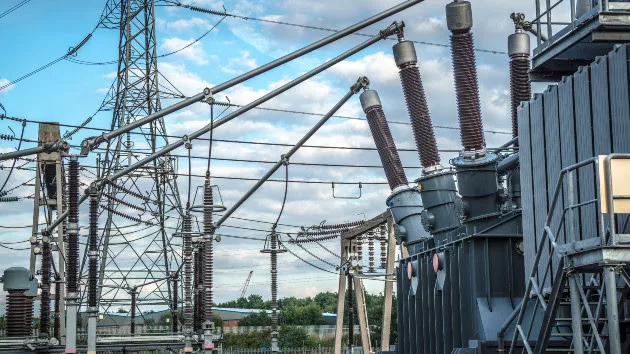
(AUSTIN, Texas) — Green energy is helping to keep the Texas power grids alive amid a weeks-long heat wave that has left power usage at an all-time high.
The perfect meteorological conditions have allowed renewable energy generated by wind turbines and solar panels to supply the grids with enough power to meet demand, experts told ABC News.
While natural gas is still the primary power source for the state’s grid, wind and solar energy are heavily contributing to the supply, data from the Electric Reliability Council of Texas shows. On Thursday afternoon, solar produced 10,757 megawatts, while wind produced 7,433 megawatts, representing about 26% of the grid’s power.
At the same time, natural gas produced 33,514 megawatts – nearly 50% of the grid’s power – while coal and lignite produced 11,357 megawatts – about 17% – the ERCOT data showed.
About 1 megawatt of power can generate electricity for 200 Texas homes during periods of peak demand, according to ERCOT, which supplies power to about 26 million customers, representing about 90% of the state’s power load. On Thursday, the more than 31,000 megawatts generated by solar and wind was enough to power more than 3.6 million homes.
Texas generates more energy than any other state, but it also consumes the most, according to the U.S. Energy Information Administration.
As of June, Texas had 36,909 megawatts of wind capacity — the most of any state in the country — and 14,813 megawatts of solar capacity. The only state with the capacity for more solar is California, with 16,416 megawatts of installed solar.
Wind and solar are also the fastest-growing electricity sources in the country, with solar power accounting for 43% of the capacity added in 2020 and wind power amounting to 38%, according to the Solar Energy Industries Association.
The load increase in Texas results from exponential growth in green energy production in recent years. The Lone Star State has been installing more wind and solar faster than ever, doubling its solar capacity in 2019-2020 and again in 2020-2021, according to the Solar Energy Industries Association.
The state is steeply increasing its production of renewable energy while usage has reached an all-time high. Peak demand is around 1% higher this year than last year, according to ICF Climate, an environmental consulting firm.
ERCOT’s annual seasonal assessment, released in May, predicted that the peak usage would come on Aug. 10 and remain at 77,317 megawatts. Those sentiments were echoed by ERCOT Public Utility Commission Chair Peter Lake, who warned in early May that the state’s main power grid could be at risk for outages during the summer if wind turbines did not produce enough electricity and usage remained in high demand.
But the peak so far came on June 27, when data from ERCOT showed that power usage hit 80,828 megawatts supplied by 6 p.m. CT, surpassing the previous record set on July 20, 2022, of 80,148 megawatts.
Fortunately for Texas residents, wind and solar energy has been optimal in the months that followed ERCOT’s seasonal assessment, Pat Milligan, senior manager and commercial energy advisory for the ICF Climate Center, told ABC News.
“There has been enough wind power, and the sun is shining,” he said. “And so things have turned out.”
Both this summer and last summer, the actual peak load day has been relatively uneventful due to higher-than-expected wind output, according to ICF Climate. But there have been near-peak days in both years that saw market prices hit the cap at $5,000 per megawatt.
Without wind and solar power, there would have been a higher likelihood of outages last week, Doug Lewin, president of Stoic Energy, director of the Texas Energy Summit and author of The Texas Energy and Power Newsletter, told ABC News.
“But what is an absolute certainty is that electric bills would have been much higher,” Lewin said.
Overall, the heavy addition of solar and wind power in recent years has likely contributed to cheaper energy prices.
Renewable energy on the Texas grid lowered the cost of electricity in the state by $11 billion in 2022, according to a report by energy systems analysis firm IdeaSmiths. Renewables have also saved Texas customers about $1,000 in electricity bills over the past five years, the analysis found.
“Wind and solar have made a massive difference, both for reliability and, very importantly, for cost as well,” Lewin said.
The additional wind and solar power also led to significant water savings because traditional fossil fuel-based power plants would have required an additional 20 billion gallons of water a year to function, the report found.
Despite the additional power supplies, the demand growth continues to severely outpace supply, leaving operations at the grid “tight,” Shanthi Muthiah, managing director, energy advisory for the ICF Climate Center, told ABC News.
“That’s left the grid more vulnerable to extreme weather,” Milligan said.
ERCOT, which issued a weather watch June 25-30 due to a continuation of triple-digit temperatures, continues to issue advisories requesting customers conserve energy during peak usage times.
But so far, the utility giant has managed to avoid emergency conditions despite a potentially deadly weather event. It is imperative that ERCOT and other utility companies around the state remain “well-planned” to avoid a grid failure amid extreme weather. That will ensure that lights — and air conditioners — stay on, Milligan said.
“Solving for and addressing the issues of reliability and affordability, along with the issues of emissions and climate, are ones that have to be done in tandem,” Muthiah said.
ABC News’ Tracy Wholf contributed to this report.
Copyright © 2023, ABC Audio. All rights reserved.





